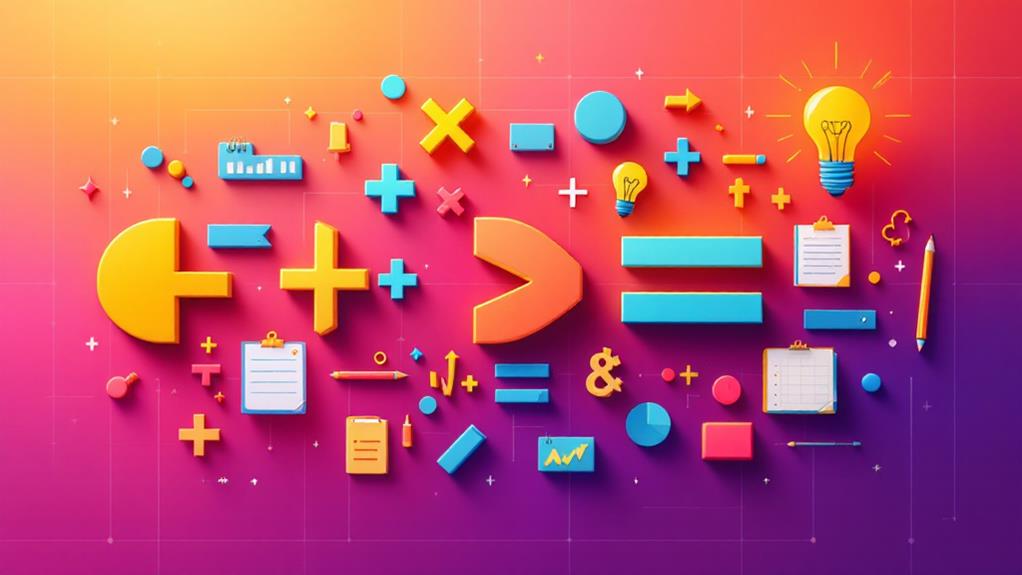Crafting attention-grabbing blog headlines is essential for attracting readers and boosting engagement. You can use various formulas to create compelling titles, such as the "How-To" approach, which offers clear guidance on specific topics. Numbers and lists provide structure and promise extensive content, while question-based headlines spark curiosity. The negative angle approach taps into readers' fears, and curiosity-driven formulas create intrigue. Problem-solution headlines directly address audience pain points, while benefit-focused headings highlight the value of your content. By mastering these formulas, you'll be well-equipped to create headlines that capture attention and drive traffic to your blog. Explore these techniques to access the potential of your content marketing strategy.
The "How-To" Formula

Mastery of the "How-To" formula can transform your blog headlines from mundane to magnetic. This powerful approach taps into your readers' desire for practical, actionable information, promising a clear solution to their problems or a path to achieving their goals.
To craft an effective "How-To" headline, start with the phrase "How to" followed by a specific, compelling action or result. For example, "How to Lose 10 Pounds in 30 Days" or "How to Double Your Productivity in One Week." The key is to be precise and quantifiable whenever possible, as this adds credibility and urgency to your headline.
You can also use variations of the "How-To" formula to keep your headlines fresh. Try "X Ways to…" or "The Ultimate Guide to…" followed by your topic. These alternatives maintain the instructional nature of the "How-To" format while offering variety.
When using this formula, focus on addressing your audience's pain points or aspirations. What do they want to learn, achieve, or overcome? Your headline should promise a clear benefit or solution.
Remember to keep your "How-To" headlines concise and easy to understand. Avoid jargon or complex language that might confuse or alienate your readers. Instead, use simple, action-oriented words that clearly communicate the value of your content.
Lastly, don't forget to deliver on your headline's promise in the article itself. Your content should provide the step-by-step guidance or information that your "How-To" headline suggests, ensuring reader satisfaction and building trust with your audience.
Numbers and Lists
The allure of numbers in headlines is undeniable. They grab attention, promise specificity, and offer a clear structure for your content. When you use numbers in your blog headlines, you're tapping into readers' desire for organized, digestible information.
To create effective numbered headlines, start with odd numbers. Research shows that odd numbers tend to perform better than even ones. For example, "7 Ways to Boost Your Productivity" is more intriguing than "6 Ways to Boost Your Productivity."
Don't shy away from larger numbers, either. Headlines like "101 Tips for Better Time Management" can be highly effective, as they suggest thorough coverage of a topic. However, confirm your content can deliver on the promise of such ambitious numbers.
Lists are closely related to numbered headlines and offer similar benefits. They provide a clear structure and make your content appear more scannable. You can use list-based headlines like "The Ultimate Checklist for Home Buyers" or "Top Reasons Why Your Diet Isn't Working."
When crafting list-based headlines, be specific about what readers will gain. Instead of "A List of Productivity Tips," try "15 Productivity Hacks That'll Save You 3 Hours a Day."
Remember to vary your approach. While numbers and lists are powerful, overusing them can make your blog feel repetitive.
Mix them with other headline formulas to keep your content fresh and engaging.
Lastly, always deliver on your headline's promise. If you claim to offer 20 tips, confirm you provide all 20. Your readers' trust depends on it.
Question-Based Headlines

While numbers and lists appeal to our desire for structure, question-based headlines tap into our natural curiosity. They're designed to pique your interest and make you want to click through to find the answer. When crafting question-based headlines, you'll want to focus on queries that your target audience is likely to ask or find intriguing.
To create effective question-based headlines, start by identifying common pain points or challenges your readers face. Then, frame these issues as questions that promise solutions or insights. For example, "How Can You Boost Your Productivity in Just 5 Minutes a Day?" or "What's the Secret to Mastering a New Language?"
You can also use question-based headlines to challenge common assumptions or present surprising information. Try headlines like "Is Your 'Healthy' Diet Actually Making You Gain Weight?" or "Could Your Smartphone Be Ruining Your Sleep?"
Remember to keep your questions specific and relevant to your content. Avoid clickbait tactics that promise more than your article delivers. Instead, verify that your headline accurately reflects the valuable information you're providing.
Question-based headlines work well for how-to guides, listicles, and expert advice pieces. They're particularly effective when addressing complex topics or offering unique perspectives on familiar subjects. By framing your content as a question, you're inviting your readers to engage with your material and seek out the answers you're offering.
To maximize the impact of your question-based headlines, consider using power words that evoke emotion or urgency. Words like "essential," "surprising," or "little-known" can add extra appeal to your questions and encourage more clicks.
Negative Angle Approach
Although counterintuitive, headlines with a negative angle can be highly effective in capturing readers' attention. This approach taps into people's natural curiosity and desire to avoid negative outcomes. By highlighting potential problems or mistakes, you create a sense of urgency that compels readers to click and learn more.
When crafting negative angle headlines, focus on common pain points or fears your audience may have. You're not aiming to be overly pessimistic, but rather to address real concerns and offer solutions. This approach works particularly well for how-to articles, cautionary tales, and problem-solving content.
To create impactful negative angle headlines, consider these strategies:
- Use words like "avoid," "stop," or "never" to emphasize prevention.
- Highlight common mistakes or pitfalls in your industry.
- Address widespread misconceptions or myths.
- Warn about potential consequences of inaction.
Remember to balance your negative headlines with positive content. While the headline may focus on a problem, your article should provide valuable solutions or insights. This contrast can make your content even more appealing, as readers will appreciate the helpful information after being drawn in by the provocative headline.
Don't overuse this technique, as it can become repetitive or off-putting if employed too frequently. Mix negative angle headlines with other types to maintain variety and keep your audience engaged.
When used strategically, negative angle headlines can greatly boost your click-through rates and help your content stand out in a crowded digital landscape.
Curiosity-Driven Formulas

Curiosity-driven formulas tap into readers' innate desire to learn and discover new information. These headline formats create a knowledge gap that compels your audience to click and read more. By piquing their curiosity, you'll increase engagement and drive traffic to your blog posts.
One effective curiosity-driven formula is the "Secret" approach. Use headlines like "The Secret to [Desired Outcome]" or "5 Little-Known Secrets of [Topic]" to entice readers. People love feeling like they're privy to exclusive information, so this formula works well for various niches.
Another powerful technique is the "Question" formula. Pose intriguing questions that your target audience wants answered, such as "Why Do [Group of People] Always [Action]?" or "What's the Real Reason Behind [Phenomenon]?" These headlines prompt readers to seek answers within your content.
The "Unusual Connection" formula creates curiosity by linking seemingly unrelated concepts. Try headlines like "What [Popular TV Show] Can Teach You About [Your Topic]" or "How [Unexpected Object] Can Improve Your [Skill]." This approach surprises readers and makes them curious about the connection.
You can also use the "Counterintuitive" formula to challenge common beliefs. Headlines like "Why [Conventional Wisdom] Is Actually Hurting Your [Goal]" or "The Surprising Truth About [Topic]" grab attention by promising to reveal unexpected information.
Lastly, the "How-To with a Twist" formula adds intrigue to standard instructional headlines. Instead of a simple "How to [Action]," try "How to [Action] Like [Unexpected Expert]" or "How to [Action] in Half the Time." These headlines promise unique methods or exceptional results, sparking curiosity and encouraging clicks.
Problem-Solution Headlines
Problem-solution headlines address specific pain points your audience faces and promise relief. These headlines are powerful because they immediately resonate with readers who are struggling with a particular issue. By offering a solution, you're giving them a compelling reason to click and read your content.
To create effective problem-solution headlines, you'll need to understand your audience's challenges and frustrations. Research common issues in your niche and use language that mirrors how your readers describe their problems. Then, hint at the solution you'll provide in your content.
Here are four key elements to include in your problem-solution headlines:
- Identify the problem clearly
- Use emotive language to emphasize the pain
- Promise a specific solution or benefit
- Create urgency or importance
Examples of problem-solution headlines include:
"Struggling with Writer's Block? Release Your Creativity with These 5 Techniques"
"Tired of Sleepless Nights? Discover the Secret to Better Sleep in Just 7 Days"
"Overwhelmed by Clutter? Learn How to Organize Your Home in 30 Minutes a Day"
Remember to deliver on the promise in your headline. If you claim to have a solution, make sure your content provides valuable, actionable advice. Avoid clickbait tactics that oversell your content and disappoint readers.
Benefit-Focused Headings

With benefit-focused headlines, you're putting the spotlight on what your readers stand to gain from your content. These headlines are powerful because they immediately showcase the value proposition of your article, enticing readers to click and engage.
To craft effective benefit-focused headings, start by identifying the core benefit your content offers. Is it saving time, money, or effort? Does it improve a skill or solve a persistent problem? Once you've pinpointed the main benefit, frame it in a way that speaks directly to your audience's desires or needs.
Use strong, action-oriented language to convey the benefit. Words like "boost," "transform," "unlock," or "master" can add impact to your headline. For example, "Boost Your Productivity: 5 Time-Saving Hacks for Busy Professionals" clearly communicates the benefit of increased productivity.
Numbers can also enhance benefit-focused headlines. They provide a concrete promise of what readers will gain. For instance, "10 Ways to Cut Your Monthly Expenses by 30%" offers a specific, quantifiable benefit.
Don't forget to take into account your audience's pain points. Addressing these directly in your headline can be highly effective. "Never Struggle with Writer's Block Again: Our Foolproof Method" targets a common problem while promising a solution.
Lastly, create a sense of urgency or exclusivity when appropriate. Phrases like "limited time," "exclusive access," or "insider secrets" can make your benefit seem more valuable and immediate.
Just make sure you deliver on these promises in your content to maintain credibility and trust with your audience.
Conclusion
You've now got a powerful toolkit of headline formulas at your disposal. Remember, these aren't rigid rules but flexible guidelines. Mix and match them, adapt them to your content, and always keep your audience in mind. Don't be afraid to experiment and track your results. With practice, you'll develop an intuitive sense for crafting headlines that grab attention, spark curiosity, and drive engagement. Now go forth and create headlines that'll make your content shine!

Erzsebet Frey (Eli Frey) is an ecologist and online entrepreneur with a Master of Science in Ecology from the University of Belgrade. Originally from Serbia, she has lived in Sri Lanka since 2017. Eli has worked internationally in countries like Oman, Brazil, Germany, and Sri Lanka. In 2018, she expanded into SEO and blogging, completing courses from UC Davis and Edinburgh. Besides Litepreneur, Eli has founded multiple websites focused on biology, ecology, environmental science, sustainable and simple living, and outdoor activities. She enjoys creating nature and simple living videos on YouTube and participates in speleology, diving, and hiking.

